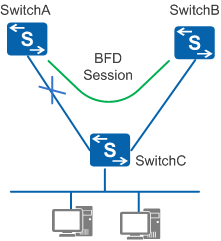BFD for VRRP
If the Virtual Router Redundancy Protocol (VRRP) master fails, the VRRP backup with the highest priority takes over traffic within a short time to shorten service interruption.
VRRP determines whether to perform preemption based on the timeout interval of the backup. The switching takes longer than 1 second. BFD can be used to quickly detect the master status and shorten traffic interruption. BFD detects real IP addresses of the master and backup devices during communication. If communication is irregular, the backup device considers the master device to be Down and takes over. A VRRP group implements an active/standby VRRP switchover quickly by tracking the BFD session status. The switchover time is within 50 milliseconds.
Application
In Figure 1, SwitchA and SwitchB establish a VRRP group. SwitchA functions as the master and SwitchB functions as the backup. User traffic is transmitted through SwitchA. SwitchA and SwitchB establish a BFD session and the VRRP group tracks the BFD session status. When the BFD session status changes, the priority of the VRRP group is changed, triggering an active/standby switchover.
- When a BFD session detects a link fault between SwitchA and SwitchC, BFD reports a Down event to VRRP.
- The priority of SwitchB in the VRRP group increases above the priority of SwitchA.
- SwitchB becomes the master switch immediately, and subsequent user traffic is forwarded through SwitchB. SwitchA becomes the backup switch.
